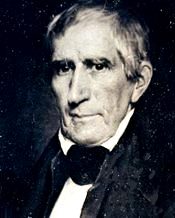The Presidents of the USA



| Born: | Feb. 9, 1773, Charles City County, Va. |
| Political party | Whig |
| Education | • Hampden-Sydney College, 1787-89 • Philadelphia College of Physicians and Surgeons, 1790 |
| Military service | U.S. Army, 1791-98, 1812-14 (Major General). Victorious leader in the battles of Tippecanoe and of Thames. |
| Previous public office | ♦ secretary of NW Territory, 1798-99 ♦ nonvoting member of U.S. House of Representatives from NW Territory, 1800 ♦ governor of Indiana Territory, 1800-12 ♦ House of Representatives, 1817-1819 ♦ Ohio Senate, 1819-21 ♦ U.S. Senate, 1825-28 ♦ U.S. minister to Colombia, 1828-29 |
| Died | Apr. 4, 1841, Washington, D.C. |
William Henry Harrison was born in Charles City County, Va., on Feb. 9, 1773, into one of the state’s leading families. His father, Benjamin Harrison, was a signer of the Declaration of Independence and governor of Virginia during the Revolution. William Henry studied at Hampden-Sidney College and at the University of Pennsylvania. He intended to study medicine to please his father. When his father died, however, he abandoned medicine for a military career.
Harrison served in the Ohio Territory and was aide-de-camp to Gen. Anthony Wayne at the Battle of Fallen Timbers (1794), which temporarily destroyed Indian power in the Northwest Territory. He married an Ohio girl, Anna Tuthill Symmes, in 1795.
Three years later he left the Army, having attained the rank of captain. He soon was appointed secretary of the Northwest Territory and elected representative to the U.S. Congress. In Congress, Harrison’s Land Act of 1800 was a major contribution to the development of America’s territorial policy. Under its terms the Federal government provided cheap land and extended each settler 5 years’ credit to pay for his property.
President John Adams appointed the experienced Harrison as governor of the Indiana Territory in 1801, when it was carved out of the Northwest Territory. During his 12 years in that post, Harrison’s main accomplishments were the establishment of a legal system, the settlement of land disputes, and the management of Indian affairs.
Harrison gained a national reputation through his victory over an Indian confederation organized by Tecumseh and his brother, the "Prophet," at the Battle of Tippecanoe. This was one of the last efforts at resistance by Indians east of the Mississippi River.
When the War of 1812 started, Harrison received a major general’s commission in the U.S. Army and, after Gen. William Hull surrendered at Detroit, took command of the Northwest forces. Although failing to achieve his primary military objectives - the recapture of Detroit and the conquest of Canada - Harrison was victorious at the Battle of the Thames in Canada in October 1813.
After the war Harrison was one of the commissioners who negotiated the Spring Wells Treaty in 1815, which completed the Federal takeover of Indian lands in the Northwest.
Upon his return to Ohio, Harrison was elected to the U.S. House of Representatives (1816-1819). In 1825 he was elected to the U.S. Senate, where he served until 1828.
In 1828 Whig president John Quincy Adams appointed Harrison ambassador to Colombia. Having little knowledge of diplomacy, Harrison promptly tangled with Colombia’s ruler, Simón Bolívar, who accused Harrison of complicity in an uprising. Incoming president Andrew Jackson, a Democrat, recalled him.
With the Whig party in temporary eclipse, Harrison returned to Ohio and went into political retirement until 1834. But the celebration that year of the twentieth anniversary of the Battle of the Thames returned him to prominence. A movement to make Harrison president gained strength in the Middle Atlantic states, where he had the backing of the leaders of the Antimasonic party, which by 1836 had largely combined with the Whigs. Since the Whig party was without a candidate for the 1836 contest and was composed of a number of discordant elements, several sectional candidates emerged to challenge the Democratic nominee, Martin Van Buren. They hoped collectively to throw the election into the House of Representatives, where one of the Whigs would emerge victorious. This strategy failed, but Harrison had proved the strongest contender.
In 1839 the Whigs united to nominate Harrison and then added Democratic defector John Tyler to the ticket. They campaigned in 1840 with the slogan “Tippecanoe and Tyler, too.” The Whigs did not adopt a party platform: they relied in image building with coonskin caps, facsimile log cabins, popular tunes, slogans, and badges that added a theatrical dimension to the emerging two-party system. They claimed that Harrison had grown up in a log cabin and hid his aristocratic plantation origins.
Although the campaign’s novel tactics may have influenced the election, the dire economic condition of the country led to a general desire for changes, which worked in Harrison’s favor.
William Henry Harrison was the first member of the Whig party to be elected President.
Harrison was nationally known as a war hero, but he had no record on political issues and his appeal was enormous. His election was more significant for the new style of politics it demonstrated than for his subsequent tenure in office because it was too short.
Between his election and inauguration, Harrison was beset by numerous party quarrels over patronage. On April 4, 1841, one month after he took office, amid signs that his party was breaking up, Harrison died of pneumonia. He may have contracted the illness at his inaugural ceremony, which took place on the coldest inauguration day in American history. The nation was stunned, having witnessed the first death of a president in office.
He served the shortest time of any President, only 32 days.